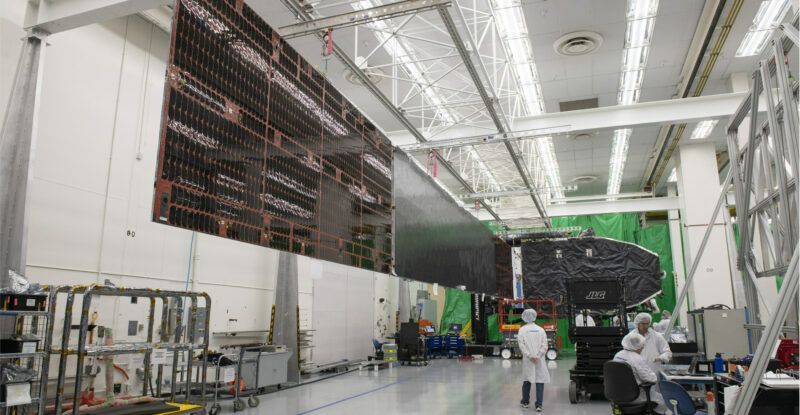Viasat’s delayed but hotly anticipated first ViaSat-3 satellite is now scheduled to launch on a SpaceX Falcon Heavy rocket on 8 April, having completed construction and testing.
The Boeing-made, high-capacity Ka-band satellite for the Americas — the first in a planned three-satellite, near global ViaSat-3 constellation — will facilitate renewed growth in Viasat’s residential business. And it will enable the satellite operator and aero ISP to continue advancing inflight connectivity for civil aviation. That business already boasts a raft of prominent airline customers including but not limited to American Airlines, Delta Air Lines, JetBlue Airways, Southwest Airlines and United Airlines.
“When we decided to undertake the ViaSat-3 program we understood there were cost and schedule risks. Existing technology, or fewer than three satellites, could not unlock the opportunities in global mobility. We’ve faced technical, manufacturing and unprecedented pandemic challenges along the way, as did our spacecraft manufacturer,” company chairman and CEO Mark Dankberg admitted in a letter to shareholders detailing Viasat’s Q3 fiscal year 2023 earnings.
He explained that the delay to the first ViaSat-3 satellite meant that Viasat’s bandwidth supply in the United States could not keep pace with the company’s very rapid inflight connectivity (IFC) growth. To address the crunch, Viasat embraced natural churn on its residential business to free up bandwidth for IFC.
“We decided to continue to grow IFC by reallocating bandwidth from residential to IFC. The upcoming launch of ViaSat-3 Americas offers abundant fuel for renewed residential growth,” assured Dankberg. This in turn will enable Viasat to add customers in inflight connectivity and a few other businesses, he said.
The ViaSat-3 EMEA satellite for Europe, Middle East, and Africa is expected to launch in September 2023. “That adds important coverage to our mobility businesses and capacity to a number of other markets,” said Dankberg during the firm’s earnings conference call. The ViaSat-3 APAC satellite for Asia-Pacific “is not too far behind that one”.
In IFC, Viasat’s program for Delta is particularly compelling for passengers, as the US major is rolling out free, Viasat-supported onboard Internet across its fleet, as JetBlue did a decade earlier. (Between the two carriers, Viasat is currently powering 3,000 flights a day with free Wi-Fi).
Having already fitted the lion’s share of Delta’s domestic fleet, Viasat expects to bring its Ka-band IFC system to the carrier’s regional jets, as well as widebody aircraft flying internationally. Rival satellite operator and aero ISP Intelsat currently powers IFC on these tails (it manages Gogo’s air-to-ground service on the RJs).
Viasat reckons it can equip the RJs and widebodies within Delta’s anticipated timeline for offering service, i.e. by the end of 2024, and in tandem with the buildout of its ViaSat-3 constellation to support near global coverage.
Said Dankberg:
On the inflight Wi-Fi, I think we do have a very good relationship with Delta and they’ve supported the notion that we’ll be their partner including on the global widebodies.
I think that’s part of what they’re looking for is consistent service across all of their fleet.
While Viasat has traditionally not installed its IFC system on commercial jets that are smaller than the Embraer E190 (as operated by JetBlue), the firm is developing products “that will go down to smaller planes”, assured Dankberg on the call. That means that Viasat has in its sights the smaller Bombardier CRJ700/900s flying regional feeder services for Delta.
Noting that Viasat already supports IFC on business jets, Dankberg explained that: “[I]t’s really a question of coming up with something that mounts well and economically for the specific types that our customers want. And so, we are working on more fuselage-mounted antennas for those smaller class of [commercial] aircraft.”
Viasat has also been developing a flat panel phased array antenna to support its aero services. “We remain excited about our work in this area, and we keep a close eye on the market, but we do not have an updated timeline to publicly offer at this stage,” a Viasat spokesman told Runway Girl Network last week.
Lightweight, slimline electronically steerable antennas are seen as especially optimized for Low Earth Orbit satellite-powered connectivity. It’s unclear if the kit would make sense for CRJs talking to Viasat’s Ka-band GEO satellites.
During the Q3 FY23 period ended 31 December 2022, Viasat pulled 160 aircraft into service, bringing its total in-service aircraft to 2,110, an increase of 17% year-over-year. It still has over 1,200 additional aircraft tails in its orderbook, and is rolling out regional deployments in China and elsewhere, sometimes in partnership with other satellite operators.
The company is gearing up to soon support new customer Southwest Airlines’ launch of Viasat service on factory-installed Boeing 737s. Southwest has orders and options for several hundred 737 MAX twinjets. Once the Viasat service goes live, passengers will be able to compare it to Southwest’s stalwart IFC provider, Anuvu, which powers $8 Wi-Fi sessions on Southwest’s in-service 737s today.
Related Articles:
- Delta hones install plan as it preps for free Wi-Fi across full fleet
- Alaska picks Intelsat multi-orbit satcom for E175s, in industry first
- Porter to offer free Wi-Fi on E2s, but fewer ads for frequent flyers
- SpaceX’s Starlink inflight Internet now active on JSX jet
- Sichuan Airlines picks Viasat high-speed Internet for 15 A320s
- Launch of first ViaSat-3 satellite delayed until early 2023
- Viasat remains bullish on IFC; says ViaSat-3 launch delayed by COVID
Featured image credited to Viasat












